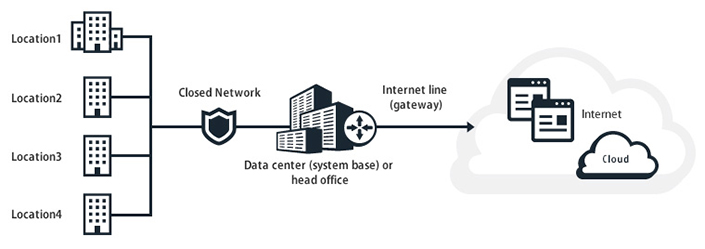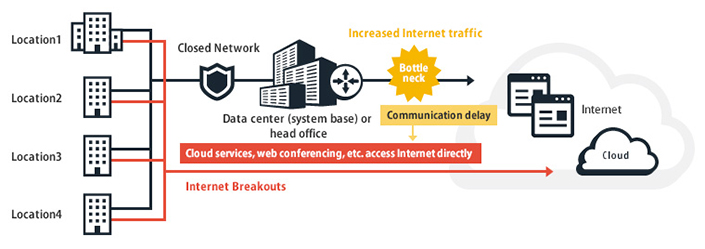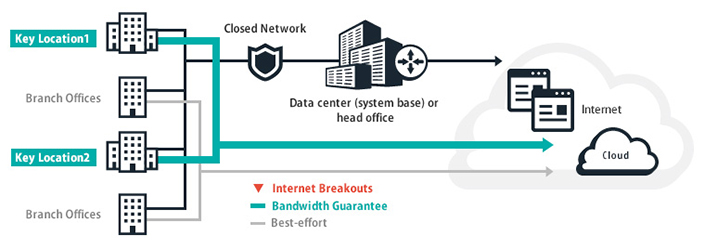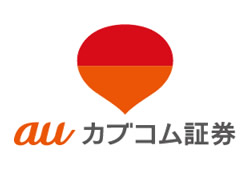Local Internet Breakouts in Japan
- Call us
- +81-3-5209-2222

Issues & Solutions for Local Internet Breakouts in Japan
What is Local Internet Breakouts?
At companies with multiple locations, the most common network configuration is to connect the central location (headquarters or data center) to local locations (branch offices, factories, etc.) with a closed network, where the Internet gateway is centralized at the central location.
In contrast, "Local Internet Breakouts" is a network configuration in which each site directly accesses the Internet.
Challenges faced by companies with multiple locations
In conventional network configurations the traffic is first sent to the central Internet gateway before being routed onto external cloud computing and web-based applications, for example.

In recent years, there has been a rapid migration of business systems and software onto the Cloud. Further accelerating factors such as the shift to work-from-home, increased access to internal networks from outside the company, the popularization of web conferencing, as well as promotion of online classes in schools, Internet traffic from outer locations has increased significantly.
As a result, the load on the Internet infrastructure at the center is constantly increasing, and there are more and more cases of communication delays due to insufficient bandwidth and general under-investment in network infrastructure.
One solution to this problem is Local Internet Breakouts.
For specific communications that may present bottlenecks (such as access to cloud services like Microsoft Office365 or web video conferencing), the Internet gateway at the center site is unused, and each site can directly connect to the Internet.
This avoids the concentration of internet traffic at the Internet gateway and eliminates the problem of bandwidth shortage.

Notes on Internet Breakouts in Japan
There are a variety of solutions for implementing Local Internet Breakouts, from the prevalent SD-WAN* to options offered by telecom firms’proprietary closed network services.
However, one detail to note is that historically, Best-effort and Shared types of Internet access services are the norm in Japan. This is a crucial detail with significant impact on end-user experience.
Even if SD-WAN is implemented to enable the distribution and control of communications, and breakout lines are laid out at each location, if the physical access lines and the Internet Gateway are of the best-effort or shared types, the problems of traffic load and delays will remain and will be noticeable during times of high traffic density. In other words, performance will depend on what other users in the surrounding area are doing.
As a result, it is inevitable that "competition for bandwidth" will occur, especially in areas where many companies are concentrated, such as in business districts or industrial parks.
* What is SD-WAN ?
SD-WAN (Software-Defined Wide Area Network) is a technology that builds a virtual WAN on top of a physical network and centrally controls the routers at each location from a management portal.
SD-WAN makes it possible to control the destination of traffic from each location and define routes according to factors such as the importance of the data to be transmitted, security requirements, etc.
In the U.S., SD-WAN has already begun to be adopted around 2014, and it is rapidly becoming popular in Japan as Local Internet Breakouts have recently gained attention.
Guaranteed Bandwidth is ideal for Local Internet Breakouts
If best-effort or shared-type access lines are inadequate or risky, depending on the importance and volume of traffic at the site, a guaranteed bandwidth line is the more reliable option.

As the everyday use of cloud services continues to increase, along with the amount of communication exchanged (such as image data and video), communication quality may be compromised due to insufficient bandwidth. If business efficiency and productivity are important goals to your organization, then investment in guaranteed bandwidth may well be justified.
When implementing Local Internet Breakouts in Japan, it is an important decision to choose between a Guaranteed Bandwidth network service and a Best-effort line.
Unitas Global's Guaranteed Bandwidth Internet is the solution
Unitas Global's Unitas MIRO Donuts Net (Internet Connectivity) is an Internet access service that offers guaranteed bandwidth with low latency thanks to the unique technology of MIRO, developed by Unitas Global Inc.
MIRO automatically optimizes BGP routes, eliminating the possibility of momentary communication failures or network delays. It is ideal for companies and corporations that want to pursue immediate and stable Internet connections to key locations. It is the best-in-class network infrastructure for Internet Breakouts.



